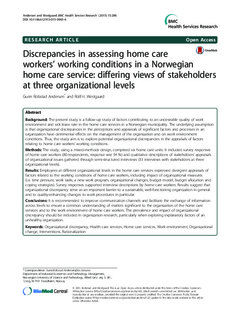| dc.contributor.author | Andersen, Gunn Robstad | |
| dc.contributor.author | Westgaard, Rolf Harald | |
| dc.date.accessioned | 2015-08-20T08:11:37Z | |
| dc.date.accessioned | 2016-04-20T12:48:23Z | |
| dc.date.available | 2015-08-20T08:11:37Z | |
| dc.date.available | 2016-04-20T12:48:23Z | |
| dc.date.issued | 2015 | |
| dc.identifier.citation | BMC Health Services Research 2015, 15(July 2015) | nb_NO |
| dc.identifier.issn | 1472-6963 | |
| dc.identifier.uri | http://hdl.handle.net/11250/2386529 | |
| dc.description.abstract | Background: The present study is a follow-up study of factors contributing to an undesirable quality of work
environment and sick leave rate in the home care services in a Norwegian municipality. The underlying assumption
is that organizational discrepancies in the perceptions and appraisals of significant factors and processes in an
organization have detrimental effects on the management of the organization and on work environment
conditions. Thus, the study aim is to explore potential organizational discrepancies in the appraisals of factors
relating to home care workers’ working conditions.
Methods: The study, using a mixed-methods design, comprised six home care units. It included survey responses
of home care workers (80 respondents, response rate 54 %) and qualitative descriptions of stakeholders’ appraisals
of organizational issues gathered through semi-structured interviews (33 interviews with stakeholders at three
organizational levels).
Results: Employees at different organizational levels in the home care services expressed divergent appraisals of
factors related to the working conditions of home care workers, including impact of organizational measures
(i.e. time pressure, work tasks, a new work program, organizational changes, budget model, budget allocation and
coping strategies). Survey responses supported interview descriptions by home care workers. Results suggest that
organizational discrepancy serve as an important barrier to a sustainable, well-functioning organization in general
and to quality-enhancing changes to work procedures in particular.
Conclusions: It is recommended to improve communication channels and facilitate the exchange of information
across levels to ensure a common understanding of matters significant to the organization of the home care
services and to the work environment of home care workers. The prevalence and impact of organizational
discrepancy should be included in organization research, particularly when exploring explanatory factors of an
unhealthy organization. | nb_NO |
| dc.language.iso | eng | nb_NO |
| dc.publisher | BioMed Central | nb_NO |
| dc.rights | Navngivelse 3.0 Norge | * |
| dc.rights.uri | http://creativecommons.org/licenses/by/3.0/no/ | * |
| dc.title | Discrepancies in assessing home care workers’ working conditions in a Norwegian home care service: differing views of stakeholders at three organizational levels | nb_NO |
| dc.type | Journal article | nb_NO |
| dc.type | Peer reviewed | nb_NO |
| dc.date.updated | 2015-08-20T08:11:36Z | |
| dc.source.volume | 15 | nb_NO |
| dc.source.journal | BMC Health Services Research | nb_NO |
| dc.identifier.doi | 10.1186/s12913-015-0945-6 | |
| dc.identifier.cristin | 1255433 | |
| dc.description.localcode | © Andersen and Westgaard. 2015. This is an Open Access article distributed under the terms of the Creative Commons Attribution License (http://creativecommons.org/licenses/by/4.0), which permits unrestricted use, distribution, and reproduction in any medium, provided the original work is properly credited. The Creative Commons Public Domain Dedication waiver (http://creativecommons.org/publicdomain/zero/1.0/) applies to the data made available in this article, unless otherwise stated. | nb_NO |

